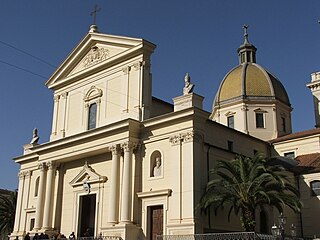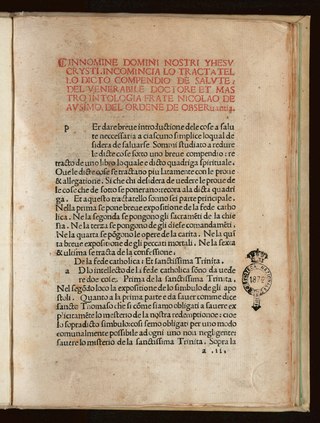
Luke Wadding, was an Irish Franciscan friar and historian.
Peter of Auvergne was a French philosopher and theologian.
NicolasBonet was a Friar Minor, philosopher, theologian, missionary and bishop of Malta.

Peter Paludanus was a French theologian and archbishop.

Matthew of Aquasparta was an Italian Friar Minor and scholastic philosopher. He was elected Minister General of the Order.

The Diocese of Cassano all'Jonio is a Latin diocese of the Catholic Church in Calabria.
Johann Wild (Ferus) was a German Franciscan scriptural commentator and preacher.

The Diocese of Mazara del Vallo is a Latin diocese of the Catholic Church in far western Sicily. It is a suffragan of the Archdiocese of Palermo.

The Archdiocese of Siracusa, also known as Syracuse, is a Latin Church ecclesiastical territory or diocese of the Catholic Church in Sicily. It became an archdiocese in 1844. The current archbishop is Francesco Lomanto.

The Diocese of Lamezia Terme is a Latin Church diocese of the Catholic Church in Calabria. In 1818 the ancient see of Martirano, the former Mamertum, was united to the diocese of Nicastro. The diocese was then a suffragan of the archdiocese of Reggio in Calabria. In 1986, the historic Diocese of Nicastro had its name changed. It is currently called the Diocese of Lamezia Terme, and it is a suffragan of the Archdiocese of Catanzaro-Squillace. The name change reflects the incorporation of the comune of Nicastro into Lamezia Terme, an administrative change of 1968 on the part of the State of Italy.
Antony Hickey was an Irish Franciscan theologian.

Aodh Mac Cathmhaoil, O.F.M., was an Irish Franciscan theologian and Archbishop of Armagh. He was known by Irish speakers at Leuven (Louvain) by the honorary name Aodh Mac Aingil, and it was under this title that he published the Irish work Scáthán Shacramuinte na hAthridhe.
John Punch (1603–1661) was an Irish Franciscan scholastic philosopher and theologian.

Bartholomew Mastrius was an Italian Conventual Franciscan philosopher and theologian.
Francesco della Rossa Bartholi was an Italian Franciscan chronicler.

Francesco Panigarola was an Italian Franciscan preacher and controversialist, and Bishop of Asti.

Nicholas of Osimo was an Italian Franciscan preacher and author.

Andreas de Vega was a Spanish theologian and Franciscan Observantine.

John Duns Scotus was a Scottish Catholic priest and Franciscan friar, university professor, philosopher and theologian. He is one of the four most important Christian philosopher-theologians of Western Europe in the High Middle Ages, together with Thomas Aquinas, Bonaventure and William of Ockham.

The Diocese of Nebbio was a Roman Catholic diocese located in the town of Saint-Florent in Corsica. The Cathedral is on a low hill one mile from the port of Saint-Florent. In the Medieval period the Bishop of Nebbio was also the temporal lord of nearly all the lands in his diocese. In 1667, Nebbio was completely abandoned and the bishop lived in Saint-Florent, a town of about 200 inhabitants, under the dominion of the Republic of Genoa. The diocese had some 22 places. The Cathedral Chapter had two dignities, the Archdeacon and the Provost, and three Canons. In 1770 the diocese was under the dominion of the King of France, and Saint-Fleur had about 600 inhabitants. The Chapter of the Cathedral still existed, with two dignities and six Canons.














